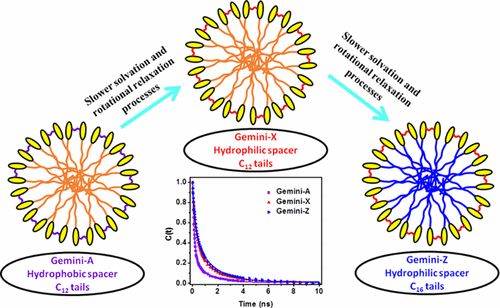Our official English website, www.x-mol.net, welcomes your feedback! (Note: you will need to create a separate account there.)
Effect of Hydrophobicity of Tails and Hydrophilicity of Spacer Group of Cationic Gemini Surfactants on Solvation Dynamics and Rotational Relaxation of Coumarin 480 in Aqueous Micelles
ACS Omega ( IF 4.1 ) Pub Date : 2017-09-18 00:00:00 , DOI: 10.1021/acsomega.7b00818 Sunita Kumari 1 , Rishika Aggrawal 1 , Sonu 1 , Sayantan Halder 1 , Ganapathisubramanian Sundar 2 , Subit K. Saha 1
ACS Omega ( IF 4.1 ) Pub Date : 2017-09-18 00:00:00 , DOI: 10.1021/acsomega.7b00818 Sunita Kumari 1 , Rishika Aggrawal 1 , Sonu 1 , Sayantan Halder 1 , Ganapathisubramanian Sundar 2 , Subit K. Saha 1
Affiliation

|
Solvation dynamics and rotational relaxation of coumarin 480 in aqueous micelles of cationic gemini surfactants with diethyl ether (EE) spacer group (m–EE–m) and tails with varying tail lengths (m = 12, 14, and 16) have been studied. Studies have been carried out by measuring UV–visible absorption, steady-state fluorescence and fluorescence anisotropy, time-resolved fluorescence and fluorescence anisotropy, 1H NMR spectroscopy, and dynamic light scattering. Effects of hydrocarbon tail length and hydrophilicity of spacer group on solvation dynamics and rotational relaxation processes at inner side of the Stern layer of micelles have been studied. With increasing hydrophobicity of tails of surfactants, water molecules in the Stern layer become progressively more rigid, resulting in a decrease in the rate of solvation process with slow solvation as a major component. With increasing hydrophilicity of the spacer group of gemini surfactant, the extent of free water molecules is decreased, thereby making the duration of the solvation process longer. Solvation times in the micelles of gemini surfactants with hydrophilic spacer are almost 4 times longer compared to those in the micelles of their conventional counterpart. Rotational relaxation time increases with increasing tail length of surfactant as a result of increasing microviscosity of micelles with fast relaxation as a major component. With increasing hydrophilicity of the spacer group, the anisotropy decay becomes slower due to the formation of more compact micelles. Rotational relaxation in gemini micelles is also slower compared to that in their conventional counterpart. The anisotropy decay is found to be biexponential with lateral diffusion of the probe along the surface of the micelle as a slow component. Rotational motion of micelle as a whole is a very slow process, and the motion becomes further slower with increasing size of the micelle. The time constants for wobbling motion and lateral diffusion of the probe become longer with increasing microviscosity of micelles.
中文翻译:

阳离子双子表面活性剂的尾巴疏水性和间隔基的亲水性对胶束水溶液中香豆素480的溶解动力学和旋转弛豫的影响
研究了带有乙醚(EE)间隔基团(m –EE– m)和具有不同尾长(m = 12、14和16)的尾巴的阳离子双子表面活性剂的水性胶束中香豆素480的溶解动力学和旋转弛豫。通过测量紫外可见吸收,稳态荧光和荧光各向异性,时间分辨荧光和荧光各向异性进行了研究,11 H NMR光谱和动态光散射。研究了烃尾长度和间隔基团的亲水性对胶束斯特恩层内侧溶剂化动力学和旋转弛豫过程的影响。随着表面活性剂尾部的疏水性增加,斯特恩层中的水分子逐渐变得更硬,从而导致以慢速溶剂化为主要成分的溶剂化过程速率降低。随着双子表面活性剂的间隔基团的亲水性增加,游离水分子的程度降低,从而使溶剂化过程的持续时间更长。具有亲水性间隔基的双子表面活性剂的胶束中的溶剂化时间比其常规对应物的胶束中的溶剂化时间长将近4倍。旋转弛豫时间随表面活性剂尾部长度的增加而增加,这是由于胶束微粘度增加而快速弛豫为主要成分所致。随着间隔基团的亲水性的增加,由于形成更紧密的胶束,各向异性衰减变慢。双子座胶束的旋转弛豫也比传统双胶束的慢。发现各向异性衰减是双指数的,探针沿着胶束表面的侧向扩散是缓慢的成分。胶束整体的旋转运动是一个非常缓慢的过程,并且随着胶束尺寸的增加,旋转运动变得更加缓慢。随着微团微粘度的增加,探头摆动和横向扩散的时间常数变长。
更新日期:2017-09-18
中文翻译:

阳离子双子表面活性剂的尾巴疏水性和间隔基的亲水性对胶束水溶液中香豆素480的溶解动力学和旋转弛豫的影响
研究了带有乙醚(EE)间隔基团(m –EE– m)和具有不同尾长(m = 12、14和16)的尾巴的阳离子双子表面活性剂的水性胶束中香豆素480的溶解动力学和旋转弛豫。通过测量紫外可见吸收,稳态荧光和荧光各向异性,时间分辨荧光和荧光各向异性进行了研究,11 H NMR光谱和动态光散射。研究了烃尾长度和间隔基团的亲水性对胶束斯特恩层内侧溶剂化动力学和旋转弛豫过程的影响。随着表面活性剂尾部的疏水性增加,斯特恩层中的水分子逐渐变得更硬,从而导致以慢速溶剂化为主要成分的溶剂化过程速率降低。随着双子表面活性剂的间隔基团的亲水性增加,游离水分子的程度降低,从而使溶剂化过程的持续时间更长。具有亲水性间隔基的双子表面活性剂的胶束中的溶剂化时间比其常规对应物的胶束中的溶剂化时间长将近4倍。旋转弛豫时间随表面活性剂尾部长度的增加而增加,这是由于胶束微粘度增加而快速弛豫为主要成分所致。随着间隔基团的亲水性的增加,由于形成更紧密的胶束,各向异性衰减变慢。双子座胶束的旋转弛豫也比传统双胶束的慢。发现各向异性衰减是双指数的,探针沿着胶束表面的侧向扩散是缓慢的成分。胶束整体的旋转运动是一个非常缓慢的过程,并且随着胶束尺寸的增加,旋转运动变得更加缓慢。随着微团微粘度的增加,探头摆动和横向扩散的时间常数变长。



























 京公网安备 11010802027423号
京公网安备 11010802027423号